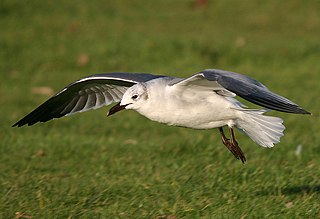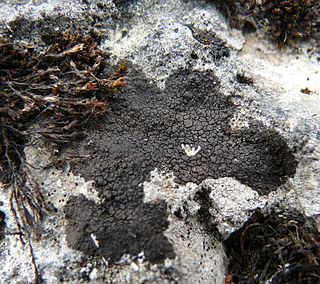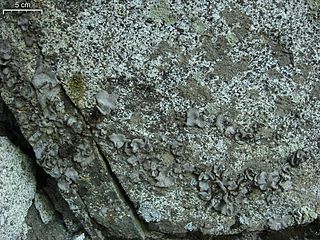
Vagrancy is a phenomenon in biology whereby an individual animal appears well outside its normal range; they are known as vagrants. The term accidental is sometimes also used. There are a number of poorly understood factors which might cause an animal to become a vagrant, including internal causes such as navigatory errors and external causes such as severe weather. Vagrancy events may lead to colonisation and eventually to speciation.

Pruinescence, or pruinosity, is a "frosted" or dusty-looking coating on top of a surface. It may also be called a pruina, from the Latin word for hoarfrost. The adjectival form is pruinose.

The Verrucariaceae are a family of mostly lichenised fungi in the order Verrucariales. The lichen-forming species, which comprise the vast majority of the family, have a wide variety of thallus forms, and include crustose (crust-like), foliose (bushy), and squamulose (scaly) representatives. Several characteristics of the spore-bearing structures, the ascomata, define the family, including their perithecioid form–more or less spherical or flask-shaped, with a single opening and otherwise completely enclosed by a wall. Squamulose members of the Verrucariaceae with simple ascospores, and without algae in the spore-bearing region are known as catapyrenioid lichens; there are more than 80 of these species. The family has several dozen lichenicolous (lichen-dwelling) examples, and a few genera that contain solely lichenicolous members. An unusually diverse variety of photobiont partners have been recorded, mostly green algae, but also brown algae and yellow-green algae.

Dermatocarpon is a genus of lichens in the family Verrucariaceae.
Neocatapyrenium is a genus of squamulose lichens in the family Verrucariaceae. It has five species. The genus was circumscribed by Hiroshi Harada in 1993, with Neocatapyrenium cladonioideum assigned as the type species.
Scleropyrenium is a genus of squamulose (scaly) lichens in the family Verrucariaceae. It has two species. The genus was circumscribed in 1993 by Japanese lichenologist Hiroshi Harada, with S. japonicum as the type species. Characteristics of the genus include a dark brown to almost black exciple, pycnidia of the Staurothele-type, and a pachydermatous upper cortex.
LAR1 refers to a specific bacterial lineage in the order Hyphomicrobiales that has most frequently been found directly in association with lichens.

Dermatocarpon americanum is a silvery-gray, leafy (foliose) lichen with black dots that is common on near seeps in rock faces from southwestern North American deserts to coastal areas. It has a silvery-dusty looking coating. It is common in deserts on vertical rock surfaces that are partially shade protected near seepages.
Adolf Hugo Magnusson was a Swedish naturalist who specialized in lichenology. He was a school teacher in Gothenburg from 1909 to 1948, but spent his spare time on the study of lichens. He described about 900 new taxa, specializing in the genera Lecidea, Lecanora, Caloplaca, and Acarospora.
Dermatocarpon miniatum is a species of fungus belonging to the family Verrucariaceae.

Dermatocarpon luridum is a species of lichen belonging to the family Verrucariaceae.
Maurice Gustave Benoît Choisy was a French mycologist and lichenologist. He was a member of the Botanical Society of France, the Mycological Society of France, and the Linnean Society of Lyon. He was president of the botanical section of the latter society from 1949 to 1950.

Placidium arboreum, commonly known as the tree stipplescale, is a species of corticolous (bark-dwelling), squamulose (scaley) lichen in the family Verrucariaceae. It has a primarily North American distribution, with a range extending from eastern Canada south to Mexico, although it has also been reported from the West Indies and from Argentina.
Dermatocarpon meiophyllizum is a species of lichen belonging to the family Verrucariaceae.
Dermatocarpon leptophyllodes is a species of lichen belonging to the family Verrucariaceae.






